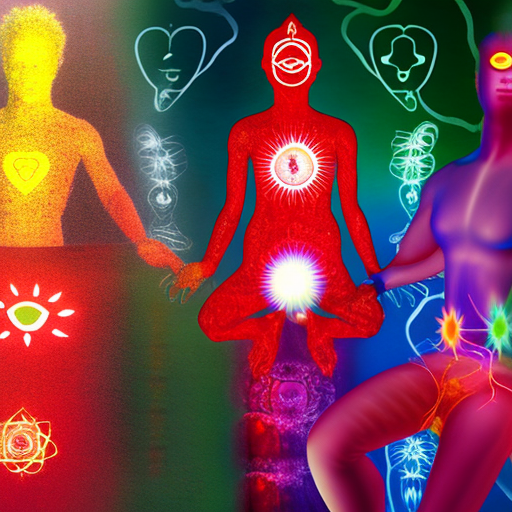Emotional Health and Chakras
The concept of chakras has been around for centuries, originating in ancient India. Chakras can be defined as the 7 centers of spiritual power in the human body. These energy centers are believed to correspond to major organs and glands, influencing our overall physical, emotional, and spiritual well-being. In recent times, the correlation between chakras and emotional health has gained popularity, as people look for ways to improve their mental and emotional state.
What are Chakras?
According to ancient Indian philosophy, each chakra is associated with a specific color, sound, element, and emotion. The 7 chakras are located along the spine, starting from the base and moving upwards to the crown of the head. They are thought to spin like wheels, allowing energy to flow throughout the body.
- Root Chakra (Muladhara): The base of the spine, represented by the color red, is associated with feelings of security, stability, and survival instincts.
- Sacral Chakra (Swadhisthana): Located just below the belly button, this chakra is symbolized by the color orange and relates to creativity, sexuality, and pleasure.
- Solar Plexus Chakra (Manipura): The third chakra, represented by the color yellow, is located in the upper abdomen. It influences self-esteem, confidence, and personal power.
- Heart Chakra (Anahata): Located in the center of the chest, the heart chakra is associated with the color green and deals with love, compassion, and emotional balance.
- Throat Chakra (Vishuddha): Represented by the color blue, this chakra is located in the throat and influences communication, self-expression, and authenticity.
- Third Eye Chakra (Ajna): Located between the eyebrows, this chakra is associated with the color indigo and is believed to enhance intuition and insight.
- Crown Chakra (Sahasrara): The highest chakra, represented by the color violet or white, is located at the top of the head and is associated with spiritual connection and enlightenment.
Impact of Chakras on Emotional Health
In Eastern philosophy, the chakras are seen as channels for the vital energy that flows through the body, known as prana. A balanced flow of energy in the chakras is believed to lead to physical, emotional, and spiritual well-being. On the other hand, blockages or imbalances in the chakras can result in physical and emotional ailments.
For instance, an overactive root chakra can manifest as fear, anxiety, and stress, while an underactive root chakra can lead to feelings of insecurity, restlessness, and lack of motivation. Similarly, an imbalanced heart chakra can cause emotional distress such as jealousy, codependency, and depression. Working towards balancing the chakras can help individuals gain control over their emotions and improve their mental, emotional, and spiritual health.
Chakra Healing for Emotional Well-being
Chakra healing can involve various practices such as crystal healing, yoga, meditation, and sound therapy, to name a few. These practices aim to clear blockages and restore the harmonious flow of energy in the chakras. By addressing emotional imbalances, chakra healing can help individuals manage their emotions better, resulting in improved emotional health.
Here are a few simple ways to balance the chakras for emotional well-being:
- Practice meditation: Focusing on each chakra and its corresponding color, sound, and emotion during meditation can help balance the energy in the chakras.
- Use crystals: Each chakra is associated with a specific crystal that can help balance its energy. For instance, amethyst can be used to balance the crown chakra, while rose quartz is ideal for the heart chakra.
- Yoga poses: Certain yoga poses, known as asanas, can help balance the energy in specific chakras. For example, the cobra pose targets the heart chakra, while the triangle pose stimulates the sacral chakra.
- Aromatherapy: Use of essential oils such as lavender, peppermint, or rosemary can help balance the chakras and promote emotional well-being.
In Conclusion
The chakras play a significant role in our emotional health and overall well-being. By understanding and working towards balancing the energy in our chakras, we can gain control over our emotions and achieve a more harmonious state of being. Incorporating chakra healing practices into our daily lives can help us maintain emotional balance and improve our overall quality of life.





Understanding and nurturing our emotional health is crucial for overall well-being. The connection between emotional health and chakras adds another layer to this understanding. Chakras are the energy centers in our bodies, and they play a vital role in our emotional health.
When our chakras are balanced and flowing freely, we experience emotional harmony and stability. On the other hand, when our chakras are blocked or imbalanced, it can lead to emotional distress and even physical ailments.
Each chakra is associated with different emotions and aspects of our lives. For example, the root chakra is linked to feelings of security and safety, while the heart chakra is associated with love and compassion. By focusing on these energy centers and removing any blockages, we can improve our emotional well-being.
Practices like meditation, yoga, and energy healing techniques can help us balance and align our chakras. These practices aim to release any stagnant energy and restore the natural flow within our bodies.
Taking care of our emotional health is essential for leading a fulfilling life. By incorporating chakra balancing practices into our routine, we can enhance our ability to handle emotions effectively and cultivate a deep sense of emotional well-being.